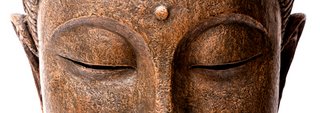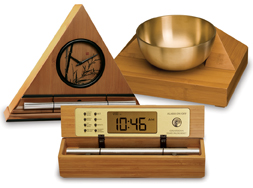
It's exquisite sounds summon your consciousness out of your meditative state with a series of subtle gongs.
Meditation is easy in theory but fiendishly difficult in practice—unless you can give your mind a vehicle for moving inward.
There are decisive moments in the flow of every meditation session—moments of transition that either sustain the momentum of practice or impede it. One of these occurs early in the meditative process, soon after relaxing the body and making it comfortable. At this point the mind naturally begins looking for a more subtle focus to carry it inward. What will that focus be?
In yogic meditation, the answer is breath awareness. Breath awareness relaxes muscles and organs, calms the nervous system, and centers the mind. It sets the stage for a profoundly penetrating concentration, and ushers in a sense of peace and well-being. Breath awareness is to meditation what good lighting is to fine photography—not its final goal, but indispensable nonetheless. Meditation unfolds through breath awareness.
The art of breath awareness is more elaborate than most of us suspect. Breathing is an organic process, and its natural sensations result from the interaction of many elements—lungs, muscles, nerves, heart, and mind. In the early moments of meditation, breath awareness means bringing the rhythmic movements of respiration into awareness, then observing and shaping them. The more tuned we are to these natural sensations of breathing, the more effortless breathing becomes.
As time passes, breath awareness shifts to the relationship between breathing and the nervous system. These two are closely linked and respond to one another like best friends. When nerves are upset, breathing is affected; when breathing relaxes, so does the nervous system.
Finally, the flow of breathing is coordinated with the repetition of a mantra, relaxing and focusing the mind. Thus breath awareness becomes a means of using the breath as a support for concentration.
Let’s look at each of these three phases more closely.

It features a long-resonating acoustic chime that brings your meditation or yoga session to a gradual close, preserving the environment of stillness while also acting as an effective time signal.
Becoming the Witness
If you direct your attention to your breath, what exactly will you feel? Which sensations are the key to breath awareness? Pervading all the sensations of breathing is the experience that exhalation is cleansing, carrying away fatigue and tension; and that inhalation is nourishing, drawing in fresh energy. Observe this repeatedly. As time passes, each time you inhale, you will be able to sustain your awareness of the breath flowing in; each time you exhale, you will feel the breath flowing out. Firmly attach your awareness to these natural rhythms of breathing and you will notice a marked improvement in your concentration.
Once you are well connected to these rhythms, pay attention to the movements of your torso in more detail. These movements reflect the selection of muscles you are using to move air in and out of the lungs. The mechanics of breathing vary, depending on the posture of your body. If you are lying down on your back, you will feel the abdomen rise and fall. But if you are sitting erect, abdominal movements are much less noticeable. Instead, with each inhalation the ribs flare to the side, with only modest expansion of the upper abdomen. Exhalation is primarily a process of releasing muscle contractions and allowing the lungs to shrink to their normal size, although you may feel the abdominal muscles mildly contracting at the end of each breath.
Sit comfortably erect, close your eyes, and examine your breathing. Find the pace that feels natural and well suited to you. Relax the muscles of the abdominal wall all the way around to the spine in the back. Then let the sides of the rib cage expand laterally with each inhalation. Although there will be little movement in the front of the chest, don’t let yourself become bound by “rules” against chest breathing. Stick to the relaxed experience of breathing, and feel the natural expansion and contraction of your body with each breath.
As you continue, begin to weave one breath into the next. Don’t hurry—simply let the transitions from breath to breath be smooth and relaxed. Extended pauses in the breath distract the mind and disturb the nervous system. When these pauses are eliminated, each breath will satisfy you, and each will come at precisely the right moment.
After a comfortable and unhurried period of working with the breath (perhaps five or six minutes), the next step is to relax all effort. Breathing is normally effortless. It flows automatically, at the periphery of awareness. During meditation, you can return to effortless breathing, yet maintain awareness at the same time. To do this, continue resting your attention on the sensations of breathing, and at the same time, relax every mental effort. Your body breathes, and your mind relaxes. You are the transparent observer of your own breathing.

Our Yoga Timer & Clock can be programmed to chime at the end of the meditation or yoga session or periodically throughout the session as a kind of sonic yantra.
Breathing is influenced by a variety of factors. Pleasant and unpleasant emotions, stress, pain, and even everyday movements alter the way we breathe. Laughter, for example, is a unique form of breathing. So are sighs, sobs, and the sharp inhalations that mark moments of sudden anxiety. Stress can have deep-acting effects, embedding itself in the fabric of the breath. Efforts to defend against chronic pain often restrict breathing, while intense pain may make the breath wildly erratic. Even bending over to tie your shoes can distort the movements of your breath.
Because the muscles of respiration are skeletal muscles, they can be controlled voluntarily. This means that you can make adjustments in breathing, reversing or at least relieving some of the effects caused by stress, pain, and negative emotions. That is one of the aims of breath awareness—the restoration of deeply relaxing patterns of breathing.
Ultimately, however, breath awareness is not so much about correcting breathing patterns as restoring the ability to witness them. Watching the breath comes naturally with a modest amount of practice. Once you are able to simultaneously relax your breathing and observe it, breath awareness will introduce you to deeper levels of yourself.
Calming the Nervous System
Painful thoughts, negative emotions, and stressful reactions inevitably arise during meditation. Having become rooted in the mind, they emerge in our practice. As we have seen, breath awareness gives us the ability to meet these distractions with less reactivity. The key is to feel the tension between relaxed breathing and these negative influences, and to choose (remember, breathing can be voluntary) to maintain a steady, relaxed flow of breath when meeting them. Even a little disturbed breathing is enough to get your heart racing and nerves tingling. Conversely, the ability to preserve relaxed breathing reestablishes a sense of self-acceptance and self-control. This calms the nervous system and creates a shift toward inner balance. It also brings us back into the present moment rather than allowing us to become enmeshed in images of the past or fantasies about the future.
Suppose, for example, that during meditation the thought of a painful work conflict arises. This thought reflects an entire array of associations, emotions, and behaviors (perhaps you’ve been avoiding meeting with a colleague for some time now). Here in meditation, nonetheless, it’s just you and your thought—meeting on the plains of your mind. The conflict will need to be worked out, no doubt, but to do that effectively may mean living with it for a time. How can breath awareness help?
The cost of stressful reactions is that they give negativity a foothold in the nervous system, which is then translated into unpleasant symptoms. During meditation, breath awareness short-circuits this translation process. It does not eliminate the conflict, but helps prevent it from taking up residence. When breathing remains relaxed and a steady focus of attention, problems are not so easily oversold to the nervous system and are less likely to overwhelm us.
Breath awareness is associated in yoga with a particular function of the mind, a function variously described as the ability to be the inner witness of experience, to remain detached in the face of discomfort, and to act decisively. Breath awareness helps create distance between this observing self in us (the buddhi in Sanskrit) and our distresses. It does not suppress conflict, but helps us recognize that conflict is not the ultimate truth of experience. Therefore, practices like breath awareness that help awaken the buddhi are particularly strengthening.
Quieting the Mind
In its final stages, breath awareness leads to a profound meditative experience. It fortifies and deepens your concentration. This is accomplished in two steps: through the sensation of the breath moving within the nostrils, and the coordination of the breath with a sound or mantra.
When the focus is on the breath flowing within the nostrils, the object of concentration is a sense experience (touch). When the breath is linked to the repetition of a mantra, it serves as a transitional device to bring the mind to a focus entirely within itself—a mental sound. Experienced meditators feel the breath in the nostrils and recite the sound of a mantra at the same time. In this way, concentration is firmly anchored.

The beauty and functionality of the Zen Clock/Timer makes it a meditation tool that can actually help you "make time" for meditation in your life. Bring yourself back to balance.
In the early stages of meditation (both in a particular meditation session and in the meditative learning process, in general), the mind is easily distracted. At that time, awareness of breathing acts like a set of training wheels on a bicycle. It allows the mind to focus, but remains ready to catch the mind if it loses its balance. The unbroken flow of breathing also prompts the mind to weave one mantra repetition into the next. As with the breath, when the sound of one mantra repetition ends, the next one begins.
With practice, the repetition of a mantra will supplant awareness of the breath. This is the inevitable direction of the meditation process. Yet slipping into the background of meditation, breathing will have performed many important functions. It is only after this work is complete that the mind turns further inward, resting in the pulsation of the mantra alone.
Use our unique “Zen Clock” which functions as a Yoga & Meditation Timer. It features a long-resonating acoustic chime that brings your meditation or yoga session to a gradual close, preserving the environment of stillness while also acting as an effective time signal. Our Yoga Timer & Clock can be programmed to chime at the end of the meditation or yoga session or periodically throughout the session as a kind of sonic yantra. The beauty and functionality of the Zen Clock/Timer makes it a meditation tool that can actually help you “make time” for meditation in your life. Bring yourself back to balance.
Rolf Sovik, PsyD, is co-author of Yoga: Mastering the Basics and is the director of the Himalayan Institute of Buffalo, New York.

It's exquisite sounds summon your consciousness out of your meditative state with a series of subtle gongs. Once you experience the Zen Timepiece's progressive tones, you'll never want to meditate any other way. It serves as the perfect meditation timer. Available in 5 wood styles, including bamboo.
Now & Zen – The Meditation Timer & Alarm Clock Store
1638 Pearl Street
Boulder, CO 80302
(800) 779-6383
orders@now-zen.com
Posted in Meditation Timers, Meditation Tools, mindfulness practice